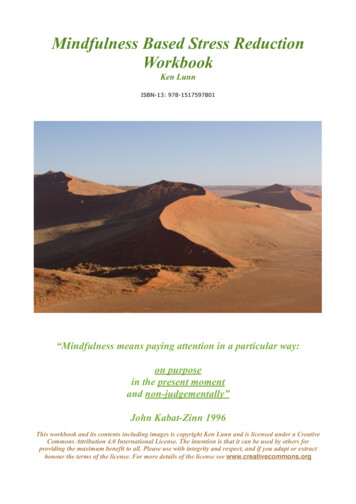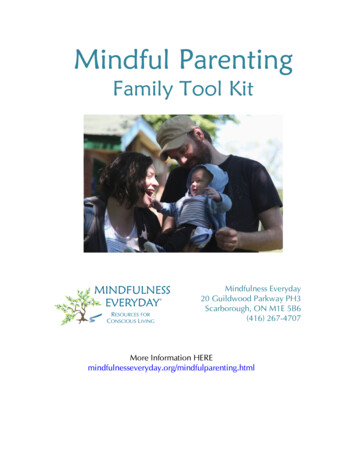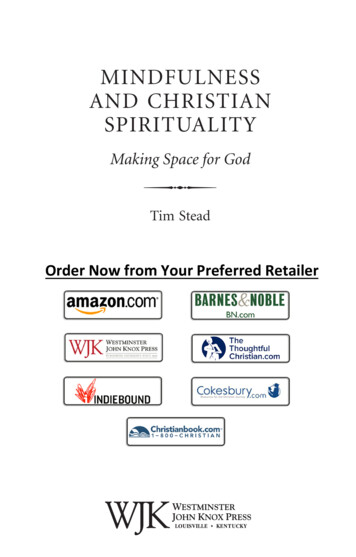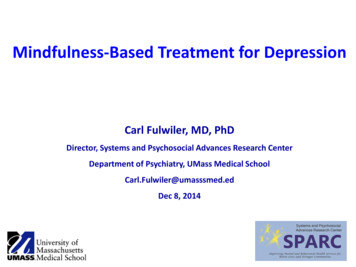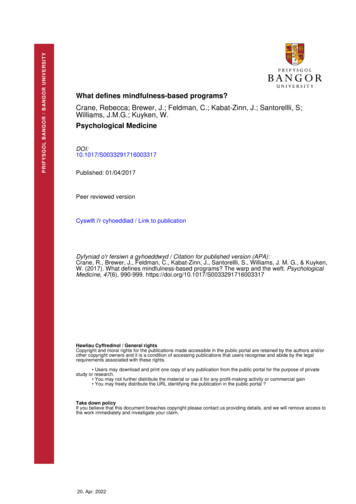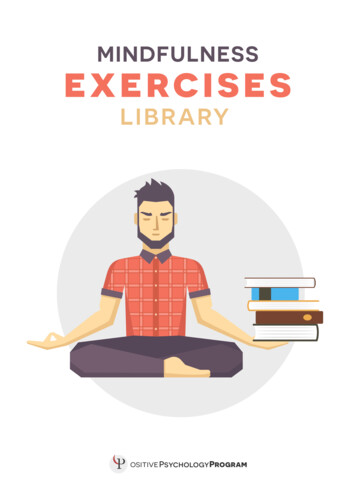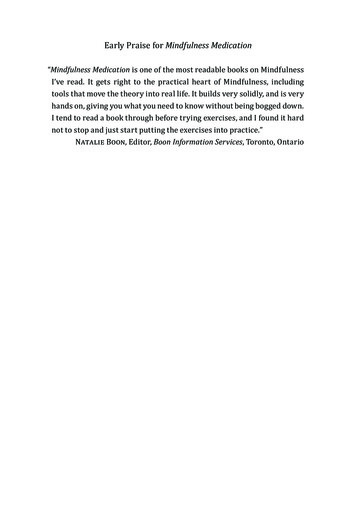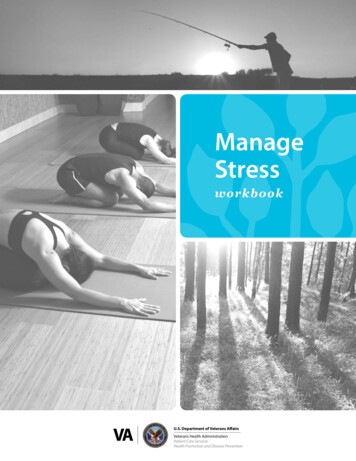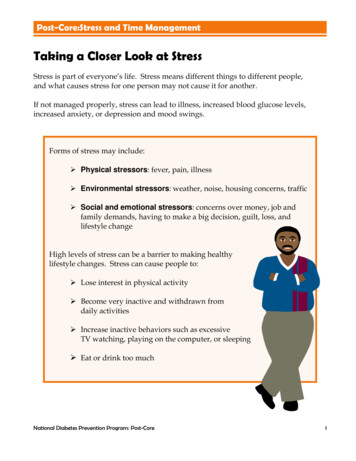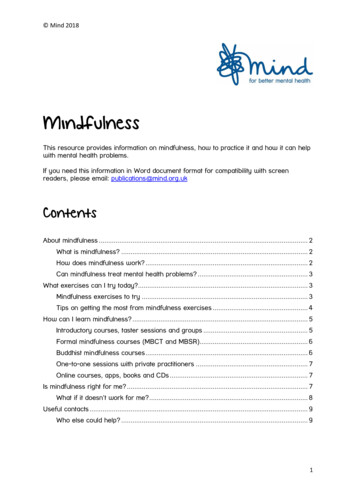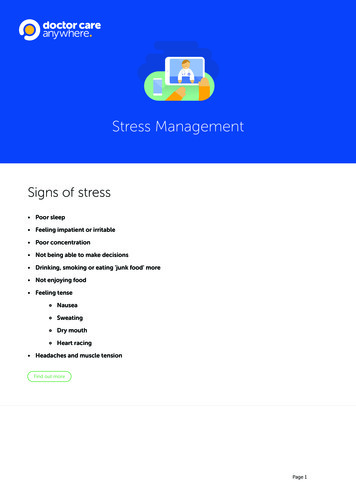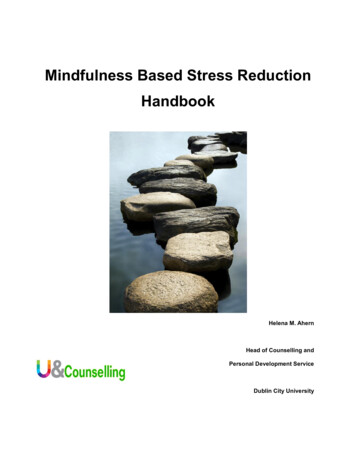
Transcription
Mindfulness Based Stress ReductionHandbookHelena M. AhernHead of Counselling andPersonal Development ServiceDublin City University
IntroductionThis eight lesson mindfulness based stress reduction guide is based on work developed by Jon KabatZinn at the University of Massachusetts Medical Centre and Bangor University of North Wales; and aimsto assist you in becoming aware of the mental, emotional and doing patterns which do not serve you well,and which you may often not even be aware of. It offers resources to stop and look at these patterns,observing how they operate and enables you to become aware of the hold they have on you. As thematerial progresses you will discover how the mind resists just being with what is and how it constantlyprojects into the future or dwells in the past.Zinn J.K, puts forward that "mindfulness provides a simple but powerful route for getting ourselvesunstuck and once we commit ourselves to paying attention in an open way, without falling prey to our likesand dislikes, opinions and prejudices, projections and expectations, new possibilities open up and wehave a chance to free ourselves from the straight jacket of unconsciousness.”Mindfulness practice has shown itself to be the most effective if you experience any of the followingexperience:–Frequently focusing on the future, thinking/worrying about some possible future event(s), and/orthinking/rummaging about an event or events in the past and not able to readily release yourmind to pay attention to the present and to what you are currently engaged in.–Feeling anxious and stressed. Feeling tension for example in your chest, shoulders, back, tummy,etc. Feeling a sense of panic and/or dread. Feeling an over-all level of anxiety/apprehension thatdisturbs your feeling of well-being.–Feeling over-whelmed and unable to separate the wood from the trees. Not able to think straightand not able to easily prioritize and organize/focus myself.–Broken-sleep patterns. Finding it difficult to go to sleep at night and/or wake up in the middle ofthe night and not able to return to sleep so readily.–Relationship stress/breakdown, conflict, communication difficulties, heightened levels ofinterpersonal stress.–Feeling down, feeling blue, not able to get motivated, poor concentration, feeling depressed.Mindfulness Defined:“Mindfulness is the awareness that arises from paying attention on purpose, in the present moment, nonjudgementally, to things as they are. It's a way of shifting from doing to being so we take in all theinformation that an experience offers us before we act. Being mindful means that we suspend judgementfor a time, set aside our immediate goals for the future, and take in the present moment as it is ratherthan as we would like it to be. It means that we approach situations with openness. Being mindfulinvolves intentionally turning off the autopilot mode in which we operate so much of the time broodingabout the past, for instance, or worrying about the future and instead tuning in to things as they are in thepresent with full awareness.The intention in mindfulness practice is not to forcibly control the mind but to perceive clearly its healthyand harmful patterns. It is to approach our minds and bodies with a sense of curiosity, openness, andacceptance so that we may see what is here to be discovered, and be with it without so much struggle. Inthis way, little by little, we begin to release ourselves from the grip of our old habits of mind. We begin toknow directly what we are doing as we are doing it. We are beginning a graceful transition fromunawareness to awareness.”Ref: Williams M., Teasdale J., Zegal Z., Zinn JK. 2007
Lesson 1Awareness of Breath - The Gateway to Awareness.One of the first things we do in mindfulness based stress reduction is to become aware of our breathwhich we often forget.You don’t have to control your breath, just notice it. Observe, watch and feel the breath with a sense ofinterest in a relaxed manner.With practice you become more aware of your breathing, and in turn are able to use it to direct yourawareness to different aspects of your life. For example to relax tense muscles, or focus on a situationthat requires attention and/or help with pain, anger, relationships or the stress of daily life.Lesson 1 - Exercise 1Mindfulness of Breathing - A Gateway to Awareness1. SettlingSettle into a comfortable straight back chair. Place your two feet flat on the floor with your legs uncrossed.Sit away from the back of the chair so your spine is self-supporting.Sit in a comfortable posture with your spine erect through not rigid. Let your shoulders relax.Gently close your eyes if that feels comfortable. If not let your gaze fall unfocused on the floor four or fivefeet in front of you.Bring your attention to the sensations of contact, the weight and pressure your body makes with the chairand the contact your feet makes with the floor.2. Focusing on the sensation of BreathingBring your focus to your breath. Be aware of how your breath is, is it deep or shallow?There is no need to change or control your breathing in any way. There is nothing to be fixed and noparticular state to achieve.Notice the breath as it travels through your nostrils, into your lungs and out through your mouth.Allow yourself for a minute or two to just be with it as it is.Now gradually bring your attention to your navel. As you inhale feel your tummy rising and as you exhalefeel your tummy falling.rising and falling.Allow your attention to settle on the full length of the breath. It may help to notice it by saying "in" or"rising" as you inhale and "out" or "falling" as you exhale.As best you can stay in touch with the changing physical sensations for the full duration of the in-breathand the full duration of the out-breath perhaps noticing the slight pauses between an in-breath and thefollowing out-breath, and between an out-breath and the following in-breath.3. Working with the mind when it wandersSooner or later (usually sooner) the mind will wander away from the focus on the breath sensation,getting caught up in thoughts, planning, day dreams, the past or just aimlessly drifting away.Whatever comes up, whatever the mind is pulled to or absorbed by, it is perfectly okay. This wanderingand getting absorbed in things is what the mind does, it is not a mistake or a failure. When the mindwanders off the breath like this simply notice it and gently escort it back to the breathing and the rise andfall of the abdomen.The more gently you are bringing your mind back the more you will experience ease. Even if the mindwanders off a thousand times that is okay, simply bring your awareness back to your breathing. Treat itwith the same gentleness you would if you were teaching a toddler to hold a ball.Continue with this practice for a few breaths or longer if you wish, reminding yourself from time to timethat the intention is simply to be aware of your breath as best as you can, using your breath as an anchorto gently reconnect with the here and now.1.
4. ClosingWhen you are ready to bring your attention back to the room or place you are in, open your eyes ifclosed; knowing you can return to the awareness of your breath at any time.Ref: Williams M, Teasdale J, Segal Z, Kabat-Zinn J. 2007 and Oscailt Mindfulness space coursehandbook 2007.Lesson 1 - Exercise 2A Three-Minute Breathing SpaceThe Breathing Space provides a way to step out ofAutomatic Pilot modeand reconnect with the present moment.1.AwarenessBring your awareness into the present moment by bringing your attention inwards. Then ask:“What is going on with me at this moment?”Whatever is going on be with it, don’t move away from it or want it to be different. Even though it oftentakes courage, train yourself to stay with it for a few moments.As you focus inwardly notice what thoughts are going through my mind right now?Acknowledge these thoughts.Notice how they arise and behave. You don't have to do anything with these thoughts, you don't have tochange, problem solve or get rid of them, simply observe and acknowledge their presence.Notice what feelings you are having. Bring words to mind that describe your current emotional experiencefor example feelings of frustration, tiredness, sadness, hurt, anger, happiness, contentment etc.Acknowledge whatever feelings are present.Scan your body and pick up any sensations you are currently experiencing. Scan your body from yourhead, shoulders, chest, arms, tummy, back, legs and sense what experiences are currently happening inyour body. They may be sensations of tightness, tension, resistance, numbness, tingling, hot or cold etc.Acknowledge these sensations. Notice these sensations without feeling driven to act on them . Be curiousand non-judgemental in approach.2.BreathNow gently bring your awareness to your breathing, bring full attention to your breath, notice is it moreshallow or deep. Being aware of each in-breath and each out-breath as they follow one after the other,sometimes it helps to count internally 1,2,3,4 when inhaling and count 4,3,2,1 when exhaling.Alternatively, it helps to say the word 'in' as you breathe in and the word 'out' as you breathe out. Yourbreathing will act as an anchor bringing you into the moment and what is specifically happening for youright now and also helping you to connect to a deeper awareness and stillness in the present momentwhile staying with whatever is happening.2.
3.ExpandExpand the field of your awareness around your breathing so that it includes your body as a whole. Senseyour body from head to toe and follow the breath into and out from the whole body. Breathe through thepores of your skin. Breathe in and out. Take a few breaths like this.Move your breath to the edge of the body and breathe.Bring your awareness to just beyond the body, to the area where the body meets the space around it, andbreathe in and out from this space.This practice connects us to a bigger container for which thoughts, feelings and sensations, without ushaving to either ignore them or act them out.This space offers the opportunity to step out of the automatic pilot and reside instead in awareness.As you return to the next part of your day bring with you this expanded awareness, and allow it toinfluence your next choice.Ref: Williams et al 2007 and Oscailt Mindfulness Space Course Handbook 2007Lesson 1 - Exercise 3A short Breathing Space to cope with difficult situations/experience1. Becoming AwareBegin by deliberately adopting an erect and dignified posture. Place your two feet flat on the ground andarms down along your side or comfortably on your lap. (If you cannot sit up-right try lying down on yourback.)You may close your eyes or alternatively allow your eyes to fall comfortably on a spot a metre or so infront of you.Allow yourself to begin to focus on your inner experiences. Moving away from your outer environmenttake a breath or two to help your attention to move inwards gently bringing your attention away from theoutside, and gently turn your attention to a challenging situation that you are currentlyexperiencing/facing; something unpleasant, something unresolved. This might be a misunderstanding oran argument, a piece of work that you are required to undertake but feel apprehensive about or a worryabout something that might/might not happen in the future.Once the troubling situation is brought to mind notice what thoughts go through your mind.Notice what you are thinking. Observe your thoughts and acknowledge them.Do not engage with them or get caught up with them.Simply observe and acknowledge them.Bring your attention to your feelings. What feelings are you aware of at this moment?Notice them. Observe them.Notice any unpleasant feelings you may be experiencing.Acknowledge their presence.You don’t have to fix or change them or do anything with them.Simply acknowledge they are there.Now turn towards any pleasant feelings. Notice and observe them.Acknowledge their presence.Bring your attention to any body sensations you may be experiencing.Scan your body (head, shoulders, arms, chest, back, tummy and legs) and pick up on any sensations;they may be sensations of tightness, tingling, tension, resistance, numbness, heat, coldness, aches or3.
others. Acknowledge these. Then when you are ready focus your attention on the region of the bodywhere the sensations are strongest, gently breathe into that part of the body; firstly breathe onto the edgeof the sensation and breathe out from its edge. Do this for a few breaths. Then breathe into the sensationitself and out from it a few times. (If at any time this becomes too much just gently bring your attentionback to your regular breath.in and out. You can return to the sensation at another time). Otherwisebreathe in and breathe out from the sensations as you soften and open.2. BreathingRedirect your attention to focus on the physical sensations of your breath and on your breathing.Focus your attention on your tummy and feel the sensations of your tummy wall expanding as youbreathe in.and falling back as you breathe out.As you breathe in, breathe through your nose and as you breathe out breath out through your mouth(allowing your mouth to fall slightly open)You don’t need to change the rate of your breathing, just become aware of it in a curious and friendly way.Notice how each breath is slightly different.If you mind wanders off, that is okay, this is what the mind does.Just gently and kindly guide your attention back to your breath.Take a few breaths like this.If you want you might say to yourself on the out breath "It's okay. whatever it is, it’s already here, let meacknowledge it".Accept yourself just as you are in this moment as much as you can.3. Consciously ExpandingNow expand the field of your awareness so that in addition to the sensation of your breath, it includes asense of your body as a whole.Breathe into your whole body through your skin. Breathe in and expand your field of awareness out to thevery outline of your bodyBring your breath to the very edge/outline of your body and breathe into the space. You can bring yourawareness to just beyond your body, to the area where the body meets the space around it. Open to thisspace and breathe into and out from this space. Do this for a few breaths.This practice connects you to a bigger container where thoughts, feelings and sensations can reside,without us having to either ignore them or act them out. This space offers us the opportunity to step out ofour automatic responses and bring our inner wisdom to bear on the situation.4. ClosingAs we come to the end of this short breathing space exercise bring your attention back to where you aresitting (or lying), gently move, open your eyes if closed and bring your expanded sense of awareness withyou.Ref: Williams et al 2007 and Oscailt Mindfulness Space Course handbook 20074.
Lesson 2"Thoughts are not facts"Segal Z., Williams M., and Teasdale J., (2002) point out that our thoughts have a very powerful influenceon the way we experience both our world and our feelings. As our thoughts vary and fluctuate so too doesour perspective on life. Our mind can be like a television set up with many channels; whatever channelwe are absorbed in determines our perspective for that particular period of time. The capacity of the mindto change its perspective is a very important one, but all too often this happens in a very mindless way. Bypaying attention to our breath we can have a greater insight into this process. The breath acts like ananchor for a mind that is constantly in motion. By bringing our awareness back to the breath rather thanidentifying with the various thought patterns that are constantly arising, we will gradually learn to get moredistance and perspective in our thought process.When we are both anchored in the breath and have created a sense of distance from our tendency toreact to thoughts as they arise in the mind, we will be able to free ourselves from the tyranny of oldthought patterns that automatically "pop into our mind". Over time and with this practice, we will realisethat our thoughts are merely mental events whose very nature it is to come and go, and not a phenomenathat has to be slavishly obeyed.By observing our thought processes on a moment-to-moment basis, we are neither suppressing,repressing, nor acting on them. This place of non-reactive observation gives us the opportunity to get toknow our minds in a deeper way than is usually possible. It also gives us the opportunity to get to knowour more frequent habitual, automatic and unhelpful thinking patterns which can lead us into downwardmood spirals. While engaging with this material, for example, it is important to become aware of thethought process that will inevitable arise that suggest, "There is no point on doing this" or “it is not goingto work, so why bother". If such thinking is slavishly followed it will sabotage and undermine your efforts,and deny you the opportunity to open up to new awareness about the nature of your own mental andthinking process.You do not need to fight your thoughts or struggle against them or judge them. Rather you can simplychoose not to follow your own thoughts once you are aware they have arisen.Take a few moments right now to look directly at the thoughts arising in your mind. As an exercise youmight like to close your eyes and imagine yourself sitting in a cinema watching an empty screen. Simplywait for thoughts to arise. Because you are not doing anything except waiting for thoughts to appear, youmay become aware of them very quickly. What exactly are they? What happens to them? Thoughts arelike magic displays that seem real when we are lost in them but often change upon inspection.But what about the strong thoughts that affect you? You are watching and then all of a sudden whoosh! you are gone, lost in thought. What is that about? What are the minds states or the particular kinds ofthoughts that catch you again and again, so that you forget that they are just phenomena passingthrough?It is amazing to observe how much power we give unknowingly to uninvited thoughts: 'Do this, say that,remember, plan, obsess, and judge’. Thoughts have the potential to drive us crazy and they often do!The kind of thoughts we have and their impact on our lives, depend on our understanding of things. If weare in the clear, powerful space of just seeing thoughts arise and pass, then it does not really matter whatkind of thinking appears in the mind; we can see our thoughts as the passing show they are.5.
From thoughts come actions. From actions come all sorts of consequences. In which thought will weinvest? Our great task is to come to see them clearly, so that we can choose which ones to act on andwhich to simply let be.When we spend some time each day in a state of non-doing, observing the flow of the breath and theactivity of our mind and body, without getting caught up in that activity, we are cultivating calmness andmindfulness hand in hand. As the mind develops stability, we strengthen the mind's ability to concentrateand to be calm.Exercise 2, Exercise 1Ways to see your thoughts differently1.Just watch your thoughts come in and leave, without thinking that you have to follow them.2.View your thoughts as a mental event rather than a fact. It may be true that this event oftenoccurs with other feelings; and when it does, it is tempting to think of it as being true. But it is stillup to you to decide whether it is true and how you want to deal with it.3.Write your thoughts down on paper. This has the effect of letting you see them in a way which isless emotional and overwhelming. Also, the pause between having the thought and writing itdown can give you a moment to reflect on its meaning.4.Ask yourself the following questions:Did this thought just pop into my head automatically?Does it fit with the fact of the situation?Is there something about it which I can question?How would I have thought about it at another time, in another situation?Are there any alternatives?5.Gently ask yourself:Am I overtired?Am I jumping to a conclusion?Am I thinking black and white terms?Am I expecting perfections?6.For particular difficult thoughts, it may be helpful intentionally to take another look at themin a balanced open state of mind and let your "Wise Mind" give its own perspective.6.
Noticing self-critical commentaryWilliams et al 2007 highlight the more we engage in the various meditation practices, the more we maynotice ourselves having reactions to what we are expecting, judging how well things are going, andcriticizing ourselves if we think we are not feeling what we are "supposed to be" feeling or that we are "notvery good" at meditating. Such occasions are wonderful opportunities to remember that judging andcriticizing are just more thinking, and can we, at such times, relate to these patterns of thinking as simplymental events?Daily meditation practice can frequently be accompanied by a running critical commentary: You've lostagain. Can't you even stay focused on your breath for half a minute? This is a waste of time. You'remessing this up just like everything else you try. Can't you get anything right? What's wrong with you?This type of commentary is a common experience; however we may come to realize that awareness ofthese patterns of thoughts, as thoughts, is meditation itself.So how can we help ourselves?Williams and his colleagues suggest one possibility is to give a name to the patterns of thinking thathabitually occur, and to use labels such as "Judging Mind" or "Hopeless Mind" or identify them as subpersonalities:"My Worst Critic," "Doubting Thomas" and so on. The important thing is that we have a wayof pointing to the common threads and general themes that cut across a range of specific thoughts thatcross our minds. Ideally, the labels that we choose should help us to drop into a wider and wiserperspective on these thought patterns. Such labels may help us to see them, with some degree ofnonattachment, as frequent visitors to the mind rather than identifying with them as part of ourselves orhearing them as the voice of true reality.We could label the whole critical judgmental package as "Critical Mind".Once we have done this we are all able to identify the critical mind when it arisesand acknowledge it. This can enable us to let the critical mind come and go,without giving it the power to trigger a cascade of negative thoughts.7.
Lesson 3Befriending feelingsAlthough our thoughts obviously affect our feelings, the thoughts originate in underlying, less perceptiblefeelings. Those feelings may persist just on the edge of awareness long after the individual negativethoughts have disappeared. So it's usually helpful once we acknowledge the presence of thoughts asmental events, to go underneath the thought level and work through directly sensed our bodyexperience(s) the feelings we get from an unpleasant experience (such a sense of anger) as well asphysical sensations (such as tightening in the shoulders). To do this, we bring an affectionate anddiscerning awareness to each aspect of our felt emotions and physical sensations.The challenge before us at this point is to see if we can be with our unwanted emotions without makingthem worse. The very notion may seem strange and the task impossible as we so easily fall into aversionand automatic mode. Yet such an intentional, conscious practice, which amounts to a paradoxicalembrace of what we fear most, can be a powerful liberating act.Once we notice an unpleasant feeling, we focus, as best we can, on how we experience it in the body.This is aided enormously by connecting our awareness of the breath, in that very moment, with whateverthe unpleasant feelings/sensations is/are. Intentionally breathe in to the area of painful or uncomfortablesensation(s), exploring its "edges" and any changes in intensity. Breathe into and out from thissensation(s). Use the next practice The Body- Scan to assist you. In such a moment, we have anopportunity to recognize any signs of aversion manifested in the body. Notice and breathe. Theawareness itself does all the work.Lesson 3 - Exercise 1The Body ScanNote: The body scan is typically done when lying down but you can assume other postures, sitting on achair with your feet uncrossed on the floor. It is not the posture that is important but rather having asincere commitment to the practice.I will be guiding you through the body scan exercise as if you were lying down, but you can internallyadopt the instructions if you are not lying down.So lying here on your bed or a mat with your arms by your sides, palms facing downwards (or facingupwards which ever feels more comfortable) gently close your eyes.Bring your attention to the body as you are lying here, and see if you can get a sense of the body in itsentirety from the crown of your head to the tips of your toes and gradually bring awareness to yourbreathing without altering or manipulating your breath in any way, just notice how you are breathing rightnow; deep or shallow, flowing smoothly or more restricted, simply observing.Notice also the weight of your body, paying attention to the weight of your head and thighs as they sink onthe bed or mat.Bring attention to the rise and fall of your abdomen as it rises with the in-breath and falls sinking backtowards the spine with the out-breath.So lying here alive and awake breathing in oxygen that nourishes the body and breathing out carbon8.
dioxide in a rhythmic cycle, gradually bring your attention from your tummy down the left thigh, past theknee, calf, foot and rest your awareness on the toes of your left foot and without moving them experiencethe big toe, the little toe and the toes in between.Notice any sensations perhaps of heat or cold, moisture, tingling, numbness. You may register a blank.that is okay too.Bring your awareness to the ball of the left foot, to the pad, arch and sole of the foot.Imagine you are breathing into and out from the pores in this region.Bring your attention to the inside ankle and the heel, perhaps experiencing the sensations of pressure,with the heel making contact with what it is resting on.Moving towards the ankle on the outside and towards the top of the foot and gradually moving upwardstowards the calf muscles, shin and shin bone, be aware of the skin on the surface and deep inside themuscle as well.If there is any tension in this region breathe right into it.Moving upwards to the knee, the knee cap and the sides of the knee and deep into the joint, breathe rightinto the knee and explore this as the best you can.Now gently let go of the knee and bring your awareness to your thigh and to your hip.Breathe into your thigh and hip and be aware of any sensations here.Experience the weight of your thigh as it makes contact with the chair (or the floor).Simply being with whatever is present.Before moving away from the left leg, imagine you are breathing into and through the hip, down throughthe leg, thigh, calf, foot and breathing out of the sole of the left foot. Do this a few times.Then breathe in through the sole and out from the hip, bring oxygen to the entire leg.Taking a couple of breaths like this, being curious, staying present and alert to any sensations.(Pause)Now let’s move over to the right toes and without moving them, spread your awareness from the big toeto the little toe and to the toes in between.Breathing in through the toes as if they were taking in oxygen. Move your attention to the sole of the rightfoot, the ball, the pad, the ankle, the inside ankle and the heel, gradually moving towards the ankle ofyour right foot and up to the top of your foot.Imagine you are breathing into and out from all the pores of your right foot.Move to the calf muscles and shin bone noticing whatever sensations are there, perhaps of blood flow,tingling or pulsation.If there is any tension or discomfort simply breathe into and let go with the out breath.Move your attention to the knee cap and the sides of the knee and into the knee joint.Become aware of your right thigh, the region between the knee and the hip.Experiencing whatever sensations are present, perhaps of tingling, blood flow, warmth, weight andcontact.Becoming aware of the entire region of the pelvis and hips, allowing the awareness to go deep into thisarea.If there is any tension or pain allow your breath or awareness to embrace it in the spirit of openness andcuriosity.Notice any sensations of weight or contact with what you are lying on.Before leaving this region imagine you are breathing deeply into the pelvis, hips, thighs, knees, calves,ankles and down into the soles of both feet and breathe out from the soles.Breathing in through the soles of the feet up through the legs, and imagine you are breathing out from thehips and pelvis.Do this for a couple of breaths.(Pause)9.
Move to the lower back region, often a region of tension for many of us.If there is any tension, tightness, heaviness or pain, breathe into it, and breathe out from it.Simply being with whatever is happening right now.(Pause)And as you move to the middle back, pause at the area of the liver and kidneys.Move to the upper back, the back of the rib-cage perhaps experiencing this region expanding with the inbreath and deflating with the out breath, and up to and between the shoulder blades.If there is any tension arising here, allow your breath to flow into and out from the area.Moving down to the tummy experiencing the rise and fall of the abdomen, the lower tummy below thenavel and then up towards the chest region and the lungs that take in the air, allowing oxygen into theblood and C2O to be removed.See if you can tune into the rhythmic beating of your heart.Gently move from this, bring your awareness to your finger tips; we can do both hands together.Being with whatever sensations you are experiencing in the tips of your fin
This eight lesson mindfulness based stress reduction guide is based on work developed by Jon Kabat-Zinn at the University of Massachusetts Medical Centre and Bangor University of North Wales; and aims to assist you in becoming aware of the mental,
